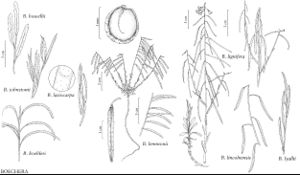Difference between revisions of "Boechera lignifera"
Phytologia 51: 370. 1982.
FNA>Volume Importer |
imported>Volume Importer |
||
| (6 intermediate revisions by 2 users not shown) | |||
| Line 7: | Line 7: | ||
|year=1982 | |year=1982 | ||
}} | }} | ||
| − | |basionyms={{Treatment/ID/ | + | |basionyms={{Treatment/ID/Basionym |
|name=Arabis lignifera | |name=Arabis lignifera | ||
|authority=A. Nelson | |authority=A. Nelson | ||
| + | |rank=species | ||
| + | |publication_title=Bull. Torrey Bot. Club | ||
| + | |publication_place=26: 123. 1899 | ||
}} | }} | ||
|synonyms= | |synonyms= | ||
| Line 26: | Line 29: | ||
|elevation=1700-2300 m | |elevation=1700-2300 m | ||
|distribution=Ariz.;Colo.;Idaho;N.Mex.;Utah;Wyo. | |distribution=Ariz.;Colo.;Idaho;N.Mex.;Utah;Wyo. | ||
| − | |discussion=<p>Boechera lignifera is commonly found on stabilized sand dunes. The related B. cobrensis often is found in similar habitats, and the two species can be difficult to distinguish where their ranges overlap in Idaho and Wyoming. It is possible that B. cobrensis was involved in the origin of some apomictic populations currently assigned to B. lignifera.</p> | + | |discussion=<p><i>Boechera lignifera</i> is commonly found on stabilized sand dunes. The related <i>B. cobrensis</i> often is found in similar habitats, and the two species can be difficult to distinguish where their ranges overlap in Idaho and Wyoming. It is possible that <i>B. cobrensis</i> was involved in the origin of some apomictic populations currently assigned to <i>B. lignifera</i>.</p> |
|tables= | |tables= | ||
|references= | |references= | ||
| Line 35: | Line 38: | ||
-->{{#Taxon: | -->{{#Taxon: | ||
name=Boechera lignifera | name=Boechera lignifera | ||
| − | |||
|authority=(A. Nelson) W. A. Weber | |authority=(A. Nelson) W. A. Weber | ||
|rank=species | |rank=species | ||
| Line 50: | Line 52: | ||
|publication year=1982 | |publication year=1982 | ||
|special status= | |special status= | ||
| − | |source xml=https:// | + | |source xml=https://bitbucket.org/aafc-mbb/fna-data-curation/src/2e0870ddd59836b60bcf96646a41e87ea5a5943a/coarse_grained_fna_xml/V7/V7_549.xml |
|tribe=Brassicaceae tribe Boechereae | |tribe=Brassicaceae tribe Boechereae | ||
|genus=Boechera | |genus=Boechera | ||
Latest revision as of 22:34, 5 November 2020
Perennials; short- to long-lived; apomictic or sexual; caudex usually woody. Stems usually 2–5 per caudex branch, arising laterally proximal to sterile shoots, often elevated on woody base, 1.2–4(–5) dm, densely pubescent proximally, trichomes short-stalked, 4–7-rayed, 0.1–0.3 mm, sparsely pubescent or glabrous distally. Basal leaves: blade narrowly oblanceolate, 2–5(–8) mm wide, margins entire, rarely ciliate near petiole base, trichomes (simple or spurred), to 1 mm, surfaces densely pubescent, trichomes short-stalked, 3–7-rayed, 0.05–0.3 mm. Cauline leaves: 4–12(–17), rarely concealing stem proximally; blade auricles 0.5–2 mm, surfaces of distalmost leaves sparsely pubescent. Racemes 6–15(–25)-flowered, usually unbranched. Fruiting pedicels slightly descending, gently recurved, 5–16 mm, glabrous or sparsely pubescent, trichomes appressed, branched. Flowers divaricate-ascending at anthesis; sepals pubescent; petals whitish (often aging pale lavender), 5–7 × 1–1.5 mm, glabrous; pollen ellipsoid or spheroid. Fruits widely pendent, not appressed to rachis, not secund, usually curved, edges parallel, 2.5–5.6 cm × 1.2–2 mm; valves glabrous; ovules 48–74 per ovary; style 0.1–0.2 mm. Seeds uniseriate, 1–1.3 × 0.8–1 mm; wing often continuous, 0.1–0.15 mm wide. 2n = 14.
Phenology: Flowering Apr–May.
Habitat: Rocky slopes and sandy soil in sagebrush and pinyon-juniper woodlands
Elevation: 1700-2300 m
Distribution

Ariz., Colo., Idaho, N.Mex., Utah, Wyo.
Discussion
Boechera lignifera is commonly found on stabilized sand dunes. The related B. cobrensis often is found in similar habitats, and the two species can be difficult to distinguish where their ranges overlap in Idaho and Wyoming. It is possible that B. cobrensis was involved in the origin of some apomictic populations currently assigned to B. lignifera.
Selected References
None.
